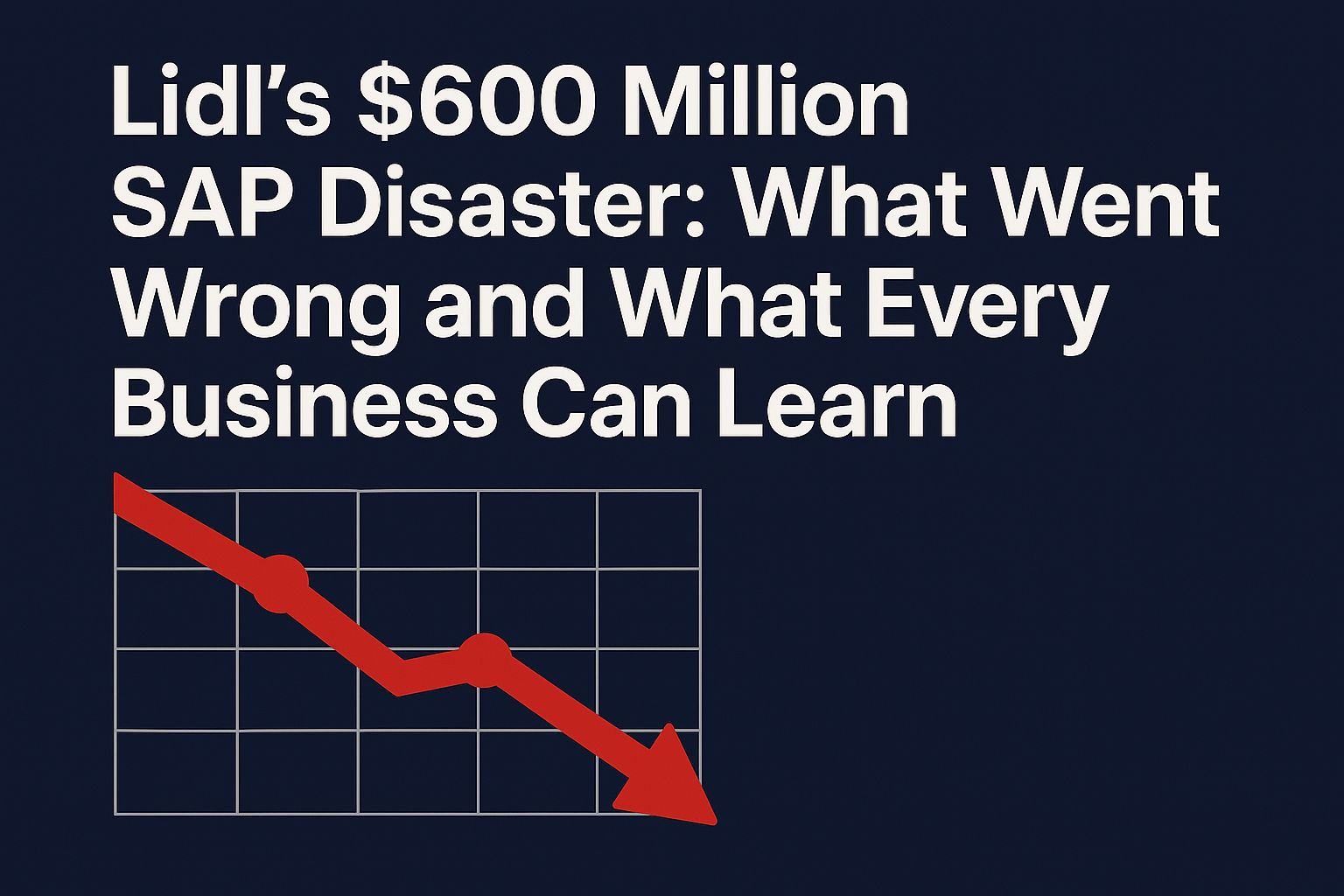In the rapidly evolving digital economy, enterprise software implementations are no longer optional—they’re essential. But when done poorly, they can lead to catastrophic outcomes. One of the most glaring examples in recent years is Lidl’s failed SAP implementation. The German-based global grocery chain invested a staggering $600 million into modernizing its enterprise systems—only to abandon the project and revert back to its legacy platform.
This isn’t just a story of wasted money. It’s a case study of leadership missteps, misaligned processes, and the dangers of underestimating change. Whether you’re a global brand or a mid-sized enterprise, the lessons from Lidl’s ERP disaster are universal—and critical.
Table of Contents
ToggleA Brief Overview: What Happened at Lidl?
Lidl, a major European grocer headquartered in Germany, operates more than 12,000 stores across 30 countries, including the U.S. The company set out to modernize its technology landscape in 2018 by implementing SAP, one of the world’s leading enterprise resource planning (ERP) systems.
The goal was clear: streamline operations, modernize processes, and unify the global business under a single platform. What unfolded, however, was anything but smooth.
After spending $600 million, Lidl scrapped the SAP rollout and returned to its legacy systems. This decision marked one of the most high-profile and expensive ERP project failures in history. The software simply didn’t align with Lidl’s operations, the implementation was plagued with issues, and in the end, the system was never fully adopted by the business.
Lesson #1: Resistance to Change Is a Project Killer
At the heart of Lidl’s failure was one of the most common (and most dangerous) threats to transformation: resistance to change.
Before SAP, Lidl valued its inventory based on the purchase price. SAP, however, used a retail price-based valuation model. While this may seem like a technical nuance, it represents a fundamental difference in how the business tracks profitability, reports financials, and manages supply chain operations.
Instead of adapting to SAP’s process—or selecting a different system that aligned better—Lidl tried to force SAP to mirror its legacy methods. This is a classic sign of resistance to change: clinging to the “old way” even when adopting new tools.
Why it matters: Digital transformation is about more than new software—it’s about evolving how a business operates. Companies must be willing to challenge outdated processes and train teams to embrace change. Without that willingness, even the best technology will fail to deliver results.
Lesson #2: Over-Customization Can Derail Your ERP Strategy
One of the most fatal decisions in Lidl’s implementation was its reliance on heavy customization. Rather than configuring SAP within its intended framework, Lidl undertook widespread modifications to make the system function like their legacy platform.
In doing so, they broke the system’s integrity. SAP is built with industry best practices in mind. Over-customizing creates technical debt, increases implementation risk, and often results in a solution that is unstable, hard to upgrade, and nearly impossible to scale.
The bigger danger is what happens down the line. Highly customized ERP systems become “trapped assets”—you can’t easily switch platforms, upgrade to newer versions, or integrate with emerging technologies. What starts as a convenience turns into a long-term liability.
Key takeaway: ERP customization should be a last resort, not a first instinct. Businesses must determine where flexibility is essential—and where it’s better to adapt to the software’s way of doing things.
Lesson #3: Overreliance on Consultants Breeds Dependency
To supplement its internal capacity, Lidl hired a large team of external consultants and system integrators. While this is a normal part of any large ERP project, Lidl’s approach tipped too far toward outsourcing control.
Lidl lacked the internal expertise and resources to manage the implementation effectively. As a result, outside vendors took the lead on too many critical components. Without a clear internal owner, the project lost accountability. And without checks and balances, costs spiraled out of control.
When a company becomes overly reliant on external implementers, it creates a dynamic of “learned helplessness.” Internal teams stop asking questions, stop engaging deeply, and ultimately lose the knowledge needed to sustain the system after go-live.
What to do instead: Use consultants to augment, not replace, your internal team. Build internal champions, upskill key personnel, and maintain tight control over strategic decision-making. No one knows your business better than you.
Lesson #4: Executive Misalignment Causes Strategic Chaos
Technology projects don’t fail in isolation—they reflect what’s happening across the organization. In Lidl’s case, there was significant executive turnover and lack of alignment at the top during the SAP implementation.
Key decisions—such as whether all stores should operate under the same process model or whether certain geographies should be autonomous—were left unanswered. Without clear direction from the executive team, project leaders and technical teams were left to guess.
The result? A moving target with shifting priorities, conflicting messages, and operational confusion. The lack of executive clarity and cohesion cascaded down through the entire organization, eroding confidence and delaying critical milestones.
Your executive team must be the backbone of your transformation. That means not only signing off on the project but actively participating in defining strategy, driving change, and making the tough calls early—before the implementation begins.
Lesson #5: ERP Software Isn’t the Problem—Strategy Is
In courtrooms and boardrooms alike, one of the first questions in any ERP failure is: “Was the software to blame?”
As Eric Kimberling rightly points out, SAP works. It powers some of the largest enterprises in the world. The problem isn’t the technology—it’s whether the strategy, implementation, and change management support the tool.
Choosing a system is only the beginning. The success of the implementation depends on aligning people, processes, and systems under a shared vision. In Lidl’s case, the technology was sound, but the environment it was dropped into was anything but ready.
The real question isn’t “does the system work?” It’s:
- Does it align with how we want to run our business in the future?
- Are we prepared to adapt our processes and culture to support this system?
- Have we built the internal structure needed to lead and sustain this change?
If the answer to those questions is no, then the best software in the world won’t save the project.
Final Thoughts: Learn from Lidl—Don’t Repeat Their Mistakes
Lidl’s $600 million failure is more than a headline. It’s a clear message to every organization undergoing digital transformation:
- Start with alignment. Make sure your executive team agrees on the direction, strategy, and guiding principles of the project.
- Embrace change. Understand that transformation means letting go of the old way, not replicating it with newer technology.
- Avoid over-customization. Work with the software—not against it.
- Empower your internal team. Consultants are helpful, but they should never run your business.
- Focus on implementation excellence. ERP success isn’t about buying the best software. It’s about executing the best plan.
In the end, Lidl’s story is a reminder that ERP success isn’t guaranteed by budget size—it’s achieved through vision, discipline, and ownership. Those who fail to learn from failures like Lidl’s risk repeating them—at equally staggering costs.






